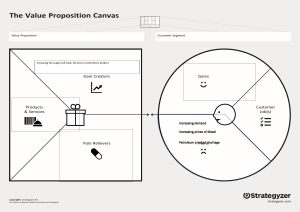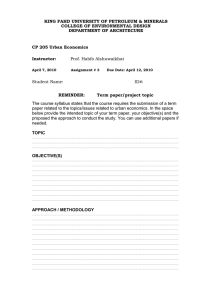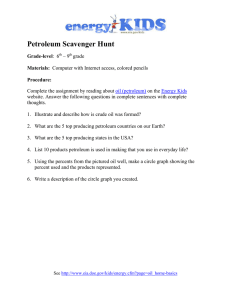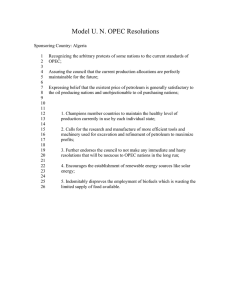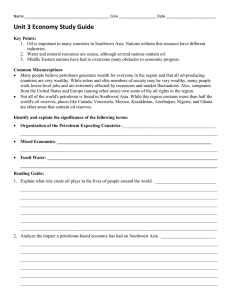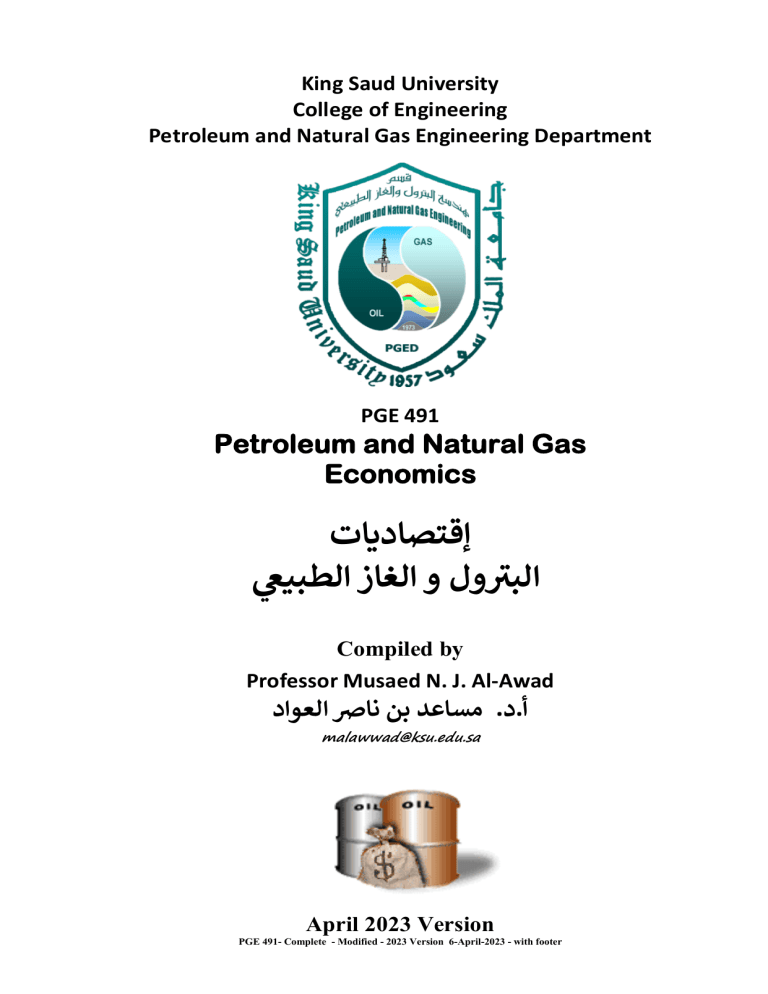
King Saud University
College of Engineering
Petroleum and Natural Gas Engineering Department
PGE 491
Petroleum and Natural Gas
Economics
إقتصاديات
ر
البتول و الغاز الطبيع
Compiled by
Professor Musaed N. J. Al-Awad
مساعد بن نارص العواد.د.أ
malawwad@ksu.edu.sa
April 2023 Version
PGE 491- Complete - Modified - 2023 Version 6-April-2023 - with footer
TABLE OF CONTENTS
INTRODUCTION
Table of Contents … 1
Course Learning Outcomes and Syllabus … 2
Brief on Worldwide Economy Systems … 3
CHAPTER 1: HISTORY OF OIL IN SAUDI ARABIA
1.1 The Importance of Oil and Gas Resources in the Middle East … 4
1.2 OPEC, USA, Rest of the World Oil Reserves, Production and Consumption … 7
1.3 History of Oil Discovery in Saudi Arabia … 8
1.4 Major Saudi Arabia Oil and Gas Fields … 11
1.5 Saudi Arabia Oil Ministers … 14
1.6 Giant Oil and Gas Fields … 15
1.7 Saudi Arabia Oil and Gas Fields List … 17
1.8 Saudi Arabia Geological Column … 19
1.9 Crude Oil Classification and Refining … 22
1.10 Carbon Net Zero Emission … 24
1.11 Carbon Capture, Utilization And Storage (CCUS) … 25
1.12 Saudi Arabia-Kuwait Neutral (Divided) Zone … 25
1.13 Legal Boundaries of Waters and Airspace … 26
1.14 Pollution Caused by Petroleum Operations … 27
CHAPTER 2: THE INTERNATIONAL OIL INDUSTRY
2.1 National and International Oil Companies and OPEC … 28
2.2 Oil and Gas Ownership Types … 28
2.3 OPEC, OPEC+, OAPEC, NOPEC, PetroDollar, and IEA … 28
2.4 Swing Produces, Inflation, Depletion, and Energy Sources … 30
2.5 Unconventional Oil and Gas Resources … 30
2.6 The Difference between Oil Shale, Shale Oil and Shale Gas? … 31
2.7 Definition of Oil and Gas Reserves … 32
2.8 Depletion and Depreciation … 34
CHAPTER 3: OIL PRICES HISTORY AND PRICING CRITERION
3.1 Oil Pricing History … 35
3.2 Oil Pricing Criterion … 37
3.3 OPEC Reference Basket (ORB) Price … 39
3.4 Oil Paper and Wet Barrels … 39
3.5 The Port of Rotterdam … 39
3.6 Law of Supply and Demand … 40
3.7 Law of Oil Equilibrium (Bottom) Price … 40
CHAPTER 4: BASICS OF ENGINEERING ECONOMY
4.1 Engineering Economy … 42
4.2 Key Factors For Successful Project … 42
4.3 Investment and Economic Limit … 43
4.4 Capital Expenditure (CAPEX) and Operating Expenditure (OPEX) … 43
4.5 Petroleum Field Exploitation Cost Analysis … 44
4.6 Nominal and Effective Interest Rates … 44
4.7 Complex Interest Rate … 45
4.8 Horizontal Time-Fund Flow Diagram … 46
4.9 Formulas for Continuous and Lump Sum Flow of Fund … 47
4.10 Mutually Exclusives Selection Methods and Decision Strategy … 47
4.11 Decision Screening Yardsticks for Economical Projects … 47
4.11.1 Net Present Value (NPV) … 48
4.11.2 Minimum Rate of Return (ROR) … 49
4.11.3 Payout (Payback) Period (POT) … 52
4.11.4 Profit-to-Investment Ratio (Profitability Index, P/I) … 54
4.12 Summary of Economical Screening Yardsticks … 56
CHAPTER 5: FIELD EXAMPLES BASED ON OIL PRODUCTION DATA
5.1 Field Examples Based On Oil Production Data … 57
CHAPTER 6: RISK, UNCERTAINTY, ETHICS, ENVIRONMENTAL IMPACTS, AND PEAK OIL THEORY
6.1 Oil and Gas Industry Sectors … 59
6.2 Potential Environmental Impacts of Oil and Gas Activities … 59
6.3 Risk and Uncertainty in the Oil and Natural Gas Industry … 60
6.4 Oil Price Elasticity … 61
6.5 Peak Oil Theory … 62
6.6 SPE Ethics and Professional Responsibility … 63 63
PGE491: Petroleum and Natural Gas Economics – Compiled by Prof. Musaed N. J. AlAwad
1
PGE 491: PETROLEUM AND NATURAL GAS ECONOMICS, 2(2-1-0)
INSTRUCTOR
Professor Musaed N. J. AlAwad
OFFERING:
Required and offered every semester
YEAR/LEVEL:
5/9
PRE-REQUISITES:
None
CO-REQUISITES:
PGE 496
TEXT BOOK
Handouts prepared by the course instructor
REFERENCES:
• Franklin J. S.: “Economic Evaluation and Investment Decision Methods.”, ISBN-13: 9781878740137, 802 pages, 14th Edition (March 1, 2014).
• Thompson & Wright: “Oil Property Evaluation”. Anthony J. Tarquin: “Engineering Economy”,
McGraw-Hill Inc., 1976.
• OPEC, OAPEC, IEA and DOE web-sites information.
. المملكة العربية السعودية، جدة، مكتبة دار حافظ للنشر والتوزيع،" "اقتصاديات البترول:• سيد فتح ي أحمد الخولي
. جامعة الملك سعود،" "صناعة النفط في عهد خادم الحرمين الشريفين الملك فهد بن عبدالعزيز:• عبدالعزيز بن لعبون
EVALUATION PLAN Home Works (10%), Mid-term exam 1 (25%), Mid-term exam 2 (25%), Final Exam (40%).
TOPICS COVERED
Brief on Islamic Economy Principles, The Importance of Oil and Gas Resources in the Middle East,
OPEC, USA, Rest of the World Oil Reserves, Production and Consumption, History of Oil Discovery in Saudi Arabia, Major
Saudi Arabia Oil and Gas Fields, Saudi Arabia Oil and Gas Fields List, Saudi Arabia Oil Ministers, Worldwide giant oil and
gas fields, Saudi Arabia Geological Column, Crude Oil Classification, Carbon Emission, Carbon Capture, Utilization And
Storage (CCUS), Saudi Arabia-Kuwait Neutral (Divided) Zone, Legal Boundaries of Waters and Airspace, Oil and Gas
Ownership Types, National and International Oil Companies and OPEC, OPEC, OPEC+, OAPEC and IEA, Swing Produces,
Inflation, Depletion, and Energy Sources, Unconventional Oil and Gas Resources, The Difference between Oil Shale, Shale
Oil and Shale Gas, Definition of Oil and Gas Reserves, Depletion and Depreciation, Oil Pricing History, Oil Pricing Criterion,
OPEC Reference Basket (ORB) Price, Oil Paper and Wet Barrels, Law of Supply and Demand, Law of Oil Equilibrium (Bottom)
Price, Engineering Economy, Key Factors For Successful Project, Investment and Economic Limit, Capital Expenditure
(CAPEX) and Operating Expenditure (OPEX), Salvage Value (S), Nominal and Effective Interest Rates, Complex Interest Rate,
Petroleum Field Exploitation Cost Analysis, Horizontal Time Line Diagram, Formulas for Continuous and Lump Sum Flow of
Fund, Mutually Exclusives Selections and Decision Methods, Decision Screening Yardsticks for Economical Projects, Net
Present Value (NPV), Minimum Rate of Return (ROR), Payout (Payback) Period (POT), Profit-to-Investment Ratio
(Profitability Index, P/I), Field Examples Based On Oil Production Data, Oil and Gas Industry Sectors, Potential
Environmental Impacts of Oil and Gas Activities, Risk and Uncertainty in the Oil and Natural Gas Industry, Oil Price
Elasticity, Peak Oil Theory, SPE Ethics and Professional Responsibility.
RELATED ABET STUDENTS OUTCOMES (SOs) and NCAAA LEARNING DOMAINS (LDs):
❖ NCAAA-K1: An ability to gain knowledge of mathematics, basic sciences, general engineering, Islamic values and
Arabic literature.
❖ ABET-SO1 (NCAAA-S1): An ability to identify, formulate, and solve complex engineering problems by applying
principles of engineering, science, and mathematics.
❖ ABET-SO4 (NCAAA-C1): An ability to recognize ethical and professional responsibilities in engineering situations and
make informed judgments, which must consider the impact of engineering solutions in global, economic,
environmental, and societal contexts.
MAIN COURSE CLOs RELATION TO PROGRAM (ABET) SOs:
CLO1: SO1
An ability to recognize knowledge of basic oil and gas industry
economical terms and related international organizations.
CLO2: SO1
An ability to evaluate petroleum engineering projects using
economic decision yardsticks and make decision among
alternatives with consideration of its impact on national and
international economics.
CLO3: SO4
An ability to recognize ethical and professional
responsibilities in engineering situations and make informed
judgments, which must consider the impact of engineering
solutions in global, economic, environmental, Risk and
Uncertainty.
SO1 = 100%
An ability to identify, formulate, and solve complex
engineering problems by applying principles of engineering,
science, and mathematics.
SO1 = 100%
An ability to identify, formulate, and solve complex
engineering problems by applying principles of engineering,
science, and mathematics.
SO4 = 100%
An ability to recognize ethical and professional
responsibilities in engineering situations and make informed
judgments, which must consider the impact of engineering
solutions in global, economic, environmental, and societal
contexts.
PGE491: Petroleum and Natural Gas Economics – Compiled by Prof. Musaed N. J. AlAwad
2
KING SAUD UNIVERSITY
COLLEGE OF ENGINEERING
PETROLEUM AND NATURAL GAS ENGINEERING DEPARTMENT
PGE 491
Petroleum and Natural Gas Economics
Professor Musaed N. J. AlAwad
Tutorial # 1: History of Oil in Saudi Arabia
1. Discuss the importance of the Middle East (Arabian Geological Plate) oil and gas resources.
2. Discuss reserves, production, and consumption rates of USA, OPEC, and the rest of the
World.
3. Outline the history of oil discovery in Saudi Arabia.
4. What is the total proven oil reserve and the total proven gas reserves in Saudi Arabia?
5. What is the current daily oil production of Saudi Arabia?
6. Discuss the main types of crude oil in terms of name, API, and example fields.
7. What is the classification of the following crude oils: 0.88 g/cc, 7.8 ppg, 61.3 pcf?
8. List the names of the major Saudi oil fields and two gas fields.
9. Discus the Saudi geological column in terms of oil reserves percentage.
10. What are the main types of sedimentary rocks in which the main Middle East of oil and gas
reservoir are located? What are their shares percentage?
11. What are the share percentages of the Middle East in the World oil and gas reserves and
production?
12. Discuss the share of medium, giant, and super giant oil fields in the World total production.
13. What are the main sources of carbon emission? Explain how captured carbon can be stored
and utilized.
14. What is the meaning of Carbon Net Zero Emission? Whys it is important? How we can stop
climate change?
15. Write a brief on Saudi Arabia-Kuwait divided (neutral) zone. Why Kuwait and KSA demand
the division of the common area between them?
16. What are the main processes may cause pollution to the environment?
PGE491: Petroleum and Natural Gas Economics – Compiled by Prof. Musaed N. J. AlAwad
64
KING SAUD UNIVERSITY
COLLEGE OF ENGINEERING
PETROLEUM AND NATURAL GAS ENGINEERING DEPARTMENT
PGE 491
Petroleum and Natural Gas Economics
Professor Musaed N. J. AlAwad
Tutorial # 2: The Intrnational Oil Industry
1. List the main national oil companies, international oil companies, and service companies
operating in Saudi Arabia.
2. What are the main types of oil and gas ownerships? Which one is applicable in Saudi Arabia?
3. Does the type of oil ownership matter?
4. What are the main types of pollution caused by petroleum operations?
5. Write a detailed essay on OPEC including its establishment, founding members, current
members, head quarter, oil basket price, etc.
6.
Write a detailed essay on OPEC+ alliance.
7. Define: Nopec, Petrodollar, Swing producer, OAPEC, IEA, Inflation, Salvage value, and
depletion.
8. Define conventional hydrocarbon resources, and then mention at least 5 unconventional
resources for oil and 4 unconventional resources for natural gas.
9. Discuss the SPE definition for oil and gas reserves?
10. Discuss the EIA definition for oil and gas reserves?
11. What is the difference between oil shale, shale oil?
12. What are the main consequences of unconventional hydrocarbon production?
PGE491: Petroleum and Natural Gas Economics – Compiled by Prof. Musaed N. J. AlAwad
65
KING SAUD UNIVERSITY
COLLEGE OF ENGINEERING
PETROLEUM AND NATURAL GAS ENGINEERING DEPARTMENT
PGE 491
Petroleum and Natural Gas Economics
Professor Musaed N. J. AlAwad
Tutorial # 3: The Intrnational Oil Industry
1.
Define physical depreciation and functional depreciation.
2.
List the top ten factors that affect the price stability of crude oil.
3.
Mention the four main properties of crude oil which control quality and price.
4. Discuss the World crude oil markers in terms of its name, geographic Location, properties,
and exchange market.
5. Write the formula used for crude oil pricing and precisely define its terms.
6. Define OPEC reference basket (ORB) price.
7. Define market clearing price. Use schematic diagrams to clarify your answer.
8. Discuss oil price history in terms of shocks occurred.
9. Define crude oil dry and wet oil barrels.
10. Discuss the law of supply and demand in terms of data required and how it is collected,
market clearing price, shortage and surplus in supply. You should use schematic diagrams to
clarify your answer.
11. Discuss the oil equilibrium (bottom) price law.
PGE491: Petroleum and Natural Gas Economics – Compiled by Prof. Musaed N. J. AlAwad
66
KING SAUD UNIVERSITY
COLLEGE OF ENGINEERING
PETROLEUM AND NATURAL GAS ENGINEERING DEPARTMENT
PGE 491
Petroleum and Natural Gas Economics
Professor Musaed N. J. AlAwad
Tutorial # 4: Basics of Engineering Economy
1. Define: Engineering Economics, Investment, Economic Limit, Capital Expenditure
(CAPEX), Operating Expenditure (OPEX), and Salvage value.
2. Discusss the main essential factors (skills) required for successful projects.
3. What is Gantt chart?
4. Define nominal interest rate and effective interest rate.
5. What is the mathematical relationship between the nominal interest rate and the effective
interest rate?
6. What is the effective annual interest rate if the nominal interest rate is 10% compounded
continuously, daily, weekly, monthly, quarterly, semi-annually, and annually? Plot your
answers for verification.
7. Define complex interest rate.
8. A customer planning to buy a house at $500,000. A bank is agreed to give him a loan of
$500,000 at a complex interest rate of 10%/year over a period of 5 years. It is required to
calculate:
•
•
•
The total amount to be paid for the bank.
The amount of the annual payments for the bank?
Bank total profit?
9. Repeat question 6 if the bank interest rate is changed to 10%/quarter.
10. Repeat question 6 if the customer will pay to the bank $100,000 in advance.
11. Define mutually exclusives selections and give examples.
12. Sketch the flow chart of investment decision making strategy.
13. List the main decision screening yardsticks for economical projects.
14. Explain how profitable projects are selected using “Decision Making Strategy”
15. Define NPV, what is the decision criterion for NPV. Write down the NPV generalized
formula.
PGE491: Petroleum and Natural Gas Economics – Compiled by Prof. Musaed N. J. AlAwad
67
KING SAUD UNIVERSITY
COLLEGE OF ENGINEERING
PETROLEUM AND NATURAL GAS ENGINEERING DEPARTMENT
PGE 491
Petroleum and Natural Gas Economics
Professor Musaed N. J. AlAwad
Tutorial # 5: Net Present Value
1. Given that i* =9%/year and inflation id =10%/year, compute Net Present Value (NPV) for
the following project, then write down your investment decision:
Stage
Development
Operation
Year
Investment, KSAR
Continuous Income, kSAR
0
1
2
3
4
5
6
7
8
0
4000
4000
2000
0
0
0
0
0
0
0
0
0
3400
3400
3400
3400
3400
2. Given that i* = 11%/year and inflation id = 8%/year, compute Net Present Value (NPV) for
the following project, then write down your investment decision:
Stage
Development
Operation
Year
Investment, KSAR
Continuous Income, kSAR
0
1
2
3
4
5
6
7
8
0
4000
3000
3000
0
0
0
2000
0
0
0
0
0
1000
5000
6000
4000
2000
3. Given that i* = 15%/year and inflation id = 10%/year, compute Net Present Value (NPV) for
the following project, then write down your investment decision:
Stage
Development
Operation
Year
0
1
2
3
4
5
6
7
Investment, MSAR
Capex
Opex
0
10
10
10
0
0
0
0
0
0
0
0
2
2
2
2
Continuous Income, MSAR
0
0
0
0
20
30
40
50
4. Given that i* = 20%/year and inflation id = 11%/year, compute Net Present Value (NPV) for
the following project, then write down your investment decision:
Stage
Year
0
Development
Operation
1
2
3
4
5
Investment, KSAR
Continuous Income, kSAR
10000
0
0
0
0
0
0
1000
5000
6000
4000
2000
PGE491: Petroleum and Natural Gas Economics – Compiled by Prof. Musaed N. J. AlAwad
68
KING SAUD UNIVERSITY
COLLEGE OF ENGINEERING
PETROLEUM AND NATURAL GAS ENGINEERING DEPARTMENT
PGE 491
Petroleum and Natural Gas Economics
Professor Musaed N. J. AlAwad
Tutorial # 6: Minimum Rate of Return
1. Define rate of return (ROR). What is the criterion used in ROR analysis?
2. Prove that when investment duration is equal to infinity (n=∞), the rate of return is given by:
i=(
AC
) = ROR
I
3. Prove when the initial investment is equal to the salvage value (I=S):, the rate of return is
given by:
i=(
AC
) = ROR
I
4. Would you invest in the following project based on rate of return value (ROR) economic
evaluation tool if the bank interest rate i* = 9%/year, inflation id = 11%/year and Salvage
value = zero?
Stage
Year
0
1
Development
2
3
4
5
Operation
6
7
8
Investment, KSAR
0
4000
4000
2000
0
0
0
0
0
Continuous Income, kSAR
0
0
0
0
3400
3400
3400
3400
3400
5. Would you invest in the following project based on rate of return value (ROR) economic
evaluation tool if the bank interest rate i* = 10%/year, inflation id = 17%/year and Salvage
value = 10000 KSAR?
Stage
Operation
Year
0
1
2
3
4
5
Investment, KSAR
10000
0
0
0
0
0
Continuous Income, kSAR
0
2500
2500
2500
2500
2500
6. Would you invest in the following project based on rate of return value (ROR) economic
evaluation tool if the bank interest rate i* = 15%/year, inflation id = 7%/year and Salvage
value = 6000 KSAR?
Stage
Year
0
Development
1
2
3
Operation
4
5
Investment, KSAR
5000
5000
0
0
0
0
Continuous Income, kSAR
0
0
3000
3000
3000
3000
PGE491: Petroleum and Natural Gas Economics – Compiled by Prof. Musaed N. J. AlAwad
69
KING SAUD UNIVERSITY
COLLEGE OF ENGINEERING
PETROLEUM AND NATURAL GAS ENGINEERING DEPARTMENT
PGE 491
Petroleum and Natural Gas Economics
Professor Musaed N. J. AlAwad
Tutorial # 7: Payback (Payout) Time
1. Define payout time (POT). What is the POT range for typical projects?
2. Write the general POT formula and draw the general plot for typical projects.
3. Why most investors are looking for minimum POT?
4. Compute the undiscounted payout time of the following project (Salvage value= 3000
kSAR):
Stage
Year
0
1
Development
2
3
4
5
Operation
6
7
8
Investment, KSAR
0
4000
4000
2000
0
0
0
0
0
Continuous Income, kSAR
0
0
0
0
3400
3400
3400
3400
3400
5. Compute the undiscounted payout time of the following project:
Stage
Year
0
1
Development
2
3
4
5
Operation
6
7
8
Investment, KSAR
0
4000
3000
3000
0
0
0
0
0
Continuous Income, kSAR
0
0
0
0
1000
5000
6000
4000
2000
6. Compute the undiscounted payout time of the following project:
Stage
Year
0
1
Development
2
3
4
5
Operation
6
7
8
Investment, KSAR
0
4000
3000
3000
0
0
0
2000
0
Continuous Income, kSAR
0
0
0
0
1000
5000
6000
4000
2000
PGE491: Petroleum and Natural Gas Economics – Compiled by Prof. Musaed N. J. AlAwad
70
7. Compute the undiscounted payout time of the following project:
Stage
Development
Operation
Year
0
1
2
3
4
5
6
7
8
9
10
11
Investment, kSAR
0
6000
5000
5000
0
0
0
1000
0
0
1000
0
Continuous Income, kSAR
0
0
0
0
5000
4000
9000
2000
4000
2000
2000
3000
8. Compute the undiscounted payout time of the following project:
Stage
Development
Operation
Year
0
1
2
3
4
5
6
7
Investment, MSAR
Capex
Opex
0
0
10
0
10
0
10
0
0
2
0
2
0
2
0
2
Continuous Income, MSAR
0
0
0
0
20
30
40
50
9. Compute the discounted and the undiscounted payout times of the following project if the
discounting factor is equal to 10%/year.
Stage
Year
Development
0
1
2
Operation
3
4
5
Investment, KSAR
10000
0
0
0
0
0
Continuous Income, kSAR
0
1000
5000
6000
4000
2000
10. Compute the discounted and the undiscounted payout times of the following project if the
discounting factor is equal to 10%/year.
Stage
Year
0
Development
1
2
3
4
Operation
5
6
7
Investment, KSAR
0
5000
5000
0
0
0
0
0
Continuous Income, kSAR
0
0
0
1000
5000
6000
4000
2000
PGE491: Petroleum and Natural Gas Economics – Compiled by Prof. Musaed N. J. AlAwad
71
KING SAUD UNIVERSITY
COLLEGE OF ENGINEERING
PETROLEUM AND NATURAL GAS ENGINEERING DEPARTMENT
PGE 491
Petroleum and Natural Gas Economics
Professor Musaed N. J. AlAwad
Tutorial # 8: Profit-to-Investment Ratio
1. Define profit-to investment ratio (P/I).
2. What is the general formula for P/I calculations?
3. What is the decision criterion for P/I?
4. If P/I for a specific project is equal to 1.5, what does it mean?
5. Neglecting inflation, compute the profit-to-investment (P/I) value and make your decision
for the following project:
Stage
Year Investment, KSAR
Continuous Income, kSAR
0
0
0
1
4000
0
Development
2
4000
0
3
2000
0
4
0
3400
5
0
3400
Operation
6
0
3400
7
0
3400
8
0
3400
6. Neglecting inflation, compute the profit-to-investment (P/I) value and make your decision
for the following project:
Stage
Year
Investment, kSAR
Continuous Income, kSAR
0
0
0
1
6000
0
Development
2
5000
0
3
5000
0
4
0
5000
5
0
4000
6
0
9000
7
4000
2000
Operation
8
0
4000
9
0
2000
10
2000
2000
11
0
3000
7. Knowing that inflation is equal to 8%/year, compute the undiscounted and discounted profitto-investment (P/I) value and make your decision for the following project:
Stage
Year Investment, KSAR
Continuous Income, kSAR
0
0
0
1
4000
0
Development
2
3000
0
3
3000
0
4
0
1000
5
0
5000
Operation
6
0
6000
7
2000
4000
8
0
2000
PGE491: Petroleum and Natural Gas Economics – Compiled by Prof. Musaed N. J. AlAwad
72
KING SAUD UNIVERSITY
COLLEGE OF ENGINEERING
PETROLEUM AND NATURAL GAS ENGINEERING DEPARTMENT
PGE 491
Petroleum and Natural Gas Economics
Professor Musaed N. J. AlAwad
Tutorial # 9: Real Field Examples
1. The following table is a historical oil production, oil prices, and operating costs in Saudi
Arabia. It is required to calculate the NPV before the start of this project in 1965 if the
inflation rate was constant at 7%/year and the salvage value is zero.
Period, Year
0
1
Development
2
Stage
3
4
5
6
7
8
9
10
11
12
13
14
15
16
17
Opration
18
Stage
19
20
21
22
23
24
25
26
27
28
29
30
31
1965
1966
1967
1968
1969
1970
1971
1972
1973
1974
1975
1976
1977
1978
1979
1980
1981
1982
1983
1984
1985
1986
1987
1988
1989
1990
1991
1992
1993
1994
1995
1996
Capex,
MMM$
0
1
10
10
5
0
0
0
0
0
0
0
0
0
0
0
0
0
0
0
0
0
0
0
0
0
0
0
0
0
0
0
Production,
bbl/day
0
0
0
0
0
3548865
4497576
5723395
7334647
8209706
6826942
8343953
9016952
8066105
9251079
9631366
9623828
6327220
4374942
3922079
3041104
4689800
3991000
4928100
4840200
6351300
8300000
8000000
8000000
8000000
8000000
8000000
Oil Price,
$/bbl
2.0
2.0
2.0
4.0
8.0
8.0
12.0
12.0
12.0
28.0
32.0
32.0
32.0
32.0
28.0
24.0
18.0
18.0
18.0
17.0
23.0
19.0
17.0
16.0
15.0
16.0
18.0
PGE491: Petroleum and Natural Gas Economics – Compiled by Prof. Musaed N. J. AlAwad
Opex,
$/bbl
0
0
0
0
0
0.5
0.5
0.5
1.0
1.0
1.2
1.6
1.6
1.6
2.5
3.0
3.0
3.0
3.0
2.0
2.0
1.5
1.5
1.5
1.5
1.7
1.7
1.75
1.8
1.9
1.95
1.95
73
2. For the following petroleum project, it is required to calculate the NET PRESENT VALUE
of the cash flow if the inflation rate is equal to 10%/year and the salvage value is zero.
Period, Year
Development
Stage
Opration
Stage
0
1
2
3
4
5
6
7
8
9
10
11
12
13
14
15
Capex,
MMM$
0
30
350
120
0
0
0
0
0
0
0
0
0
0
0
0
1988
1989
1990
1991
1992
1993
1994
1995
1996
1997
1998
1999
2000
2001
2002
2003
Production,
MMbbl/day
0
0
0
0
8
8
9
9
10
10
9
9
10
10
8
8
Oil Price,
$/bbl
20
25
25
25
30
30
40
40
50
50
55
55
Opex,
$/bbl
0
0
0
0
2.5
2.5
2.5
2.5
2.5
2.5
2.5
2.5
2.5
2.5
2.5
2.5
3. Using the following data, it is required to use NPV analysis to compare between vertical
and horizontal oil wells profitability for one operation (production) year.
Oil viscosity = 3.5 cp,
Oil price = 35 $/bbl, Inflation rate (discounting factor) =
9%/year
Oil formation volume factor (o) = 1.1 bbl/STB,
Wellbore diameter = 5.0 inch
Average reservoir pressure = 3382 psi,
Wellbore pressure = 1142 psi
Reservoir thickness = 22 ft, Reservoir average permeability = 0.236 Darcy,
Drainage area = 139 acres, Horizontal section of the horizontal well = 1000 ft
Operating cost = 5 $/bbl,
Vertical well drilling and completion cost (at the end of year 1) = MM$1.5
Horizontal well drilling and completion cost (at the end of year 1) = MM$3.5
qv = {
7.081 k h ∆P
r }
βo μ ln (r e )
w
7.081 k h ∆P
qh =
2
βo μ ln
L
1 + √1 + (2 r )
d
h
h
+ (L) ln (2 π r )
w
L
(2 r )
d
[{
}
]
PGE491: Petroleum and Natural Gas Economics – Compiled by Prof. Musaed N. J. AlAwad
74
KING SAUD UNIVERSITY
COLLEGE OF ENGINEERING
PETROLEUM AND NATURAL GAS ENGINEERING DEPARTMENT
PGE 491
Petroleum and Natural Gas Economics
Professor Musaed N. J. AlAwad
Tutorial # 10: Risk, Uncertainty, and Ethics
1. Define the following terms:
•
•
•
•
•
•
•
•
Upstream oil industry
Midstream oil industry
Downstream oil industry
Risk
Opportunity
Threat
Uncertainty
Oil price elasticity, and inelasticity. Which one of them is oil price follows?
2. Using market supply and demand surveys shown below, it is required to determine the type
of price elasticity of supply.
Price, $
1
2
3
4
5
Supply #1, Boxes
1.5
1.8
2.1
2.1
2.7
Supply #2, Boxes
1.5
3.5
5.5
7.5
9.5
3. What is the impact of petroleum exploration and production industry activities on the
environment?
4. Discuss the technical, economical and political risks involved in the petroleum exploration
and production industry.
5. Write down the genral equation used for price elasticity of supply (Pre) and define its terms.
6. Using schematic diagram, outline price elasticity cahge for: oil & gas, subsidized goods,
monopoly, and other goods.
7. Briefly discuss the peak oil theory. Why its forecasts failed several times since 1974?
8. Define the term ethics? Then outline SPE code of conduct for professional actions and
behavior.
PGE491: Petroleum and Natural Gas Economics – Compiled by Prof. Musaed N. J. AlAwad
75

